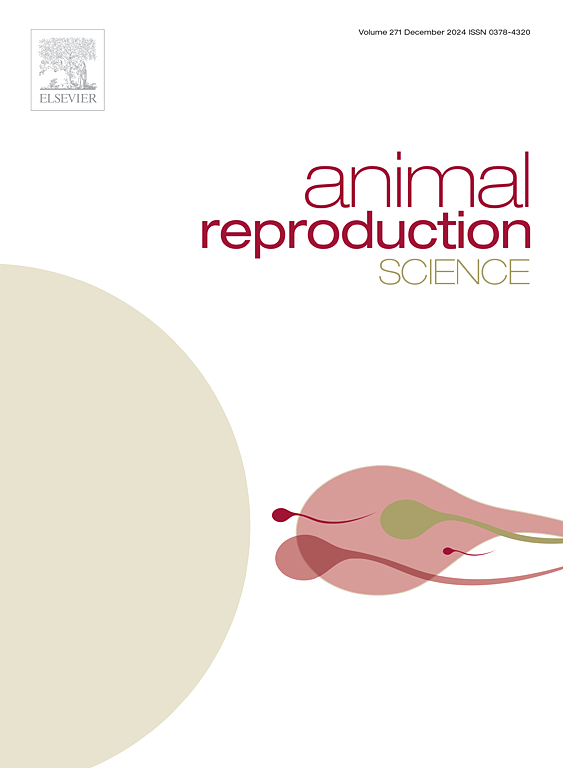miR-1307/BRCA1 axis mediated oxidative stress promotes apoptosis of sow ovarian granulosa cells
IF 2.2
2区 农林科学
Q1 AGRICULTURE, DAIRY & ANIMAL SCIENCE
引用次数: 0
Abstract
Breast cancer associated gene 1 (BRCA1) mutation and consequential reduction in transcription cause cancer, predominantly in the breast and ovarian tissues. However, its noncancer-related functions in ovarian tissues remain largely unknown. Here, we report BRCA1 is strongly involved in sow granulosa cell (sGC) apoptosis and cycle, and is targeted and inhibited by the pro-apoptotic miR-1307. BRCA1 is highly abundant in sGCs, and up-regulated during sow follicular development, but weakly expressed in atretic follicles, indicating a close correlation with sow follicular development and atresia. A loss-of-function assay showed that BRCA1 suppresses sGC apoptosis and promotes cell cycle progression. Furthermore, miR-1307 is a pro-apoptotic factor that inhibits BRCA1 by targeting the 3′UTR of the latter. In addition, the miR-1307 and BRCA1 axis can be activated by oxidative stress (OS), which is related to the transcriptional activation of miR-1307 by FoxO3, a transcription factor activated by OS. In conclusion, this study provides a basis for understanding the role of BRCA1 in sow reproduction and a theoretical target for improving sow fertility.
miR-1307/BRCA1轴介导的氧化应激促进母猪卵巢颗粒细胞凋亡
乳腺癌相关基因1 (BRCA1)突变和相应的转录减少导致癌症,主要发生在乳房和卵巢组织。然而,其在卵巢组织中的非癌症相关功能在很大程度上仍然未知。在这里,我们报道BRCA1强烈参与母猪颗粒细胞(sGC)的凋亡和周期,并被促凋亡的miR-1307靶向和抑制。BRCA1在sGCs中含量丰富,在母猪卵泡发育过程中表达上调,但在闭锁卵泡中表达较弱,表明BRCA1与母猪卵泡发育和闭锁密切相关。功能缺失分析显示BRCA1抑制sGC凋亡并促进细胞周期进展。此外,miR-1307是一种促凋亡因子,通过靶向BRCA1的3'UTR抑制BRCA1。此外,miR-1307和BRCA1轴可被氧化应激(OS)激活,这与氧化应激激活的转录因子FoxO3对miR-1307的转录激活有关。综上所述,本研究为了解BRCA1在母猪繁殖中的作用提供了基础,也为提高母猪肥力提供了理论靶点。
本文章由计算机程序翻译,如有差异,请以英文原文为准。
求助全文
约1分钟内获得全文
求助全文
来源期刊

Animal Reproduction Science
农林科学-奶制品与动物科学
CiteScore
4.50
自引率
9.10%
发文量
136
审稿时长
54 days
期刊介绍:
Animal Reproduction Science publishes results from studies relating to reproduction and fertility in animals. This includes both fundamental research and applied studies, including management practices that increase our understanding of the biology and manipulation of reproduction. Manuscripts should go into depth in the mechanisms involved in the research reported, rather than a give a mere description of findings. The focus is on animals that are useful to humans including food- and fibre-producing; companion/recreational; captive; and endangered species including zoo animals, but excluding laboratory animals unless the results of the study provide new information that impacts the basic understanding of the biology or manipulation of reproduction.
The journal''s scope includes the study of reproductive physiology and endocrinology, reproductive cycles, natural and artificial control of reproduction, preservation and use of gametes and embryos, pregnancy and parturition, infertility and sterility, diagnostic and therapeutic techniques.
The Editorial Board of Animal Reproduction Science has decided not to publish papers in which there is an exclusive examination of the in vitro development of oocytes and embryos; however, there will be consideration of papers that include in vitro studies where the source of the oocytes and/or development of the embryos beyond the blastocyst stage is part of the experimental design.
 求助内容:
求助内容: 应助结果提醒方式:
应助结果提醒方式:


